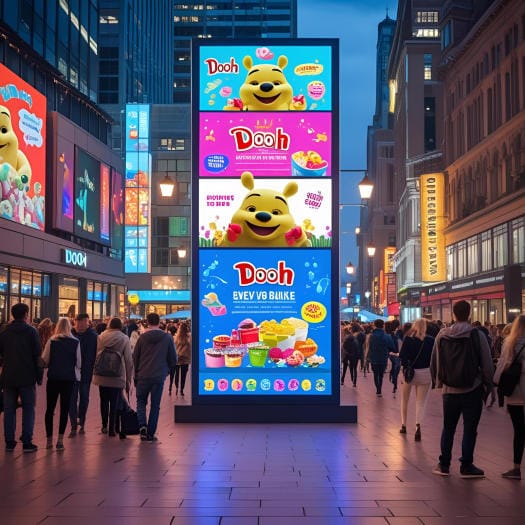What is DOOH advertising?
A New Era of Out-of-Home Media
For decades, static billboards defined outdoor advertising—bold, fixed, and impossible to update without printing new material. But today’s audiences expect motion, relevance, and immediacy. That shift has given rise to digital out-of-home DOOH advertising, a format powered by real-time content, dynamic visuals, and flexible scheduling. When businesses ask what DOOH advertising is, the answer is simple: it’s outdoor media reimagined for the digital world.
The Modern DOOH Landscape
The current DOOH ecosystem transcends a bright screen. It also has data-driven campaigns, contextual messaging, automated scheduling, and full DOOH advertising networks that coordinate hundreds or thousands of displays in cities, malls, transit hubs, and restaurants. Weather information, traffic of people, and social media trends—all this may be displayed on the DOOH screen.
Introducing Nento’s Role
Nento enables companies to exploit this new frontier. Nento offers everything necessary as a full-service DOOH advertising company; it includes commercial-grade hardware, a user-friendly CMS, scalable network management, and strategic support. Nento will make DOOH come to life, whether it is a single restaurant or a nationwide campaign, with professional precision.
Ready to see DOOH in action? Explore Nento’s Digital Signage Solutions.
Why DOOH Advertising? The Core Benefits
Unmatched Reach and Frequency
DOOH screens are typically placed in high foot traffic locations—from shopping streets to airport terminals. These screens capture the audience at a time when they are most likely to pay attention, when they are idle.
Real-world insight: Research shows DOOH ads can achieve up to 70% higher recall than static posters.
Dynamic and Flexible Content
DOOH campaigns are not print-based and therefore change immediately. The brands can refresh promotional messages every hour, react to what is happening, alternate creatives during the campaign, or A/B test to determine which one works best.
Enhanced Targeting and Relevance
Contextual triggers are incorporated in modern DOOH:
- Weather-related advertising (e.g. iced coffee in hot weather)
- Time-of-day campaigns
- Location tendencies of the audience.
This will lead to more intelligent and relevant communication that will appeal to the DOOH audience.
Measurable Impact and Analytics
Businesses can now track:
- Impressions and display time.
- Interaction (QR scans, pedestrian lift)
- Campaign comparisons
- Playback proof
DOOH has evolved from guesswork to measurable performance.
High Recall and Brand Impact
Motion captivates. Micro-animations, high-resolution screens, and bright typography make impressions in the crowded setting. DOOH is one of the most powerful branding tools in combination with intelligent content cycles.
Want to leverage these benefits for your brand? Speak with a Nento DOOH Expert Today!
Nento’s DOOH Advertising Solutions: A Tailored Approach
For Businesses of All Sizes
DOOH Advertising Agencies:
Agencies rely on the platform at Nento to launch, plan, and optimize campaigns on a number of client accounts. They are able to operate campaigns on a large scale without operational chaos, thanks to centralized control.
DOOH Advertising Enterprise:
In the case of big companies and franchises, Nento provides more sophisticated networks, strong permissions, and central control, which are the key elements of a strong DOOH advertising enterprise ecosystem.
Our Core Technology Stack
Commercial-Grade Hardware:
Bright, tough, and usable outdoors or indoors—and able to work twenty-four hours a day.
Intuitive Cloud Software:
The CMS of Nento enables anyone to post content, schedule playlists, monitor devices, or push live updates from any browser.
Connected Network Management:
Easily control a national DOOH advertising network with just a few clicks. Group screens, run campaigns by location, and review performance analytics—all working together flawlessly.
Discover the perfect DOOH solution for your business. View Our Products.
Spotlight: DOOH for Dining—A Recipe for Success
Unique Challenges of the Dining Industry
Restaurants operate in a fast, competitive environment. Menus are changed, specials are switched, customers come and go, and ambiance is important. That level of dynamism simply can’t be maintained on static boards. DOOH addresses all these issues in a graceful manner.
How DOOH for Dining Provides the Solution
Dynamic Menu Boards:
Display mouthwatering images, spotlight combos, update pricing automatically, or give seasonal meals full-motion graphics.
Reducing Perceived Wait Times:
Waits can feel shorter with screens showing queue progress, “now preparing” messages, fun animations, local news, or brand stories.
Social Proof & Reviews:
Include live Instagram posts, customer reviews, or trending hashtags—making your restaurant part of the community conversation.
Upselling Made Effortless:
Subtle animations pointing to “Add Fries,” “Upgrade to Large,” or “Try Our New Dessert” can increase average order value dramatically.
Integrating with Operations
More sophisticated operators may add CRM-based advertising, where loyalty app information would prompt personalized greetings or individual offers.
Transform your restaurant’s marketing and operations. Learn More About DOOH for Dining with Nento.

Building a Winning DOOH Advertising Strategy
Defining Your Goals and Audience
Is your aim brand awareness? In-store conversions? Foot-traffic lift? All the goals affect the position of screens, innovative design, and time schedule.
Content Is King
The material should be huge, readable, and digestible in a few seconds. The highest-performing DOOH advertisements employ
- High contrast
- Short messaging
- Large visuals
- Micro-animations
Location Strategy
Select placements that are customer-moment aligned. For example:
- Approaching impulse purchases at checkout.
- At the promotion entrances.
In places where they eat to tell stories.
Measure and Optimize
Apply the available KPIs: dwell time, QR scans, footfall trends, or menu item uplift. Campaigns are optimized continuously and thus become more efficient.
Need help crafting your strategy? Download Nento’s Free DOOH Strategy Template.
Frequently Asked Questions (FAQs)
What is DOOH advertising, and how is it different from billboards?
DOOH involves digital screens with changeable information and dynamic updates that are missing in the case of the static billboards that need to be replaced manually.
Is DOOH for dining only for large chains?
No. Small cafes, single-location restaurants, and food trucks are the recipients of the flexibility and overwhelming visual effect of DOOH.
What is a DOOH advertising network?
One central CMS with a connected grid of screens to enable synchronized campaigns.
How do I measure ROI in DOOH?
Through promo performance tracking, QR scans, foot traffic lift, scheduling data, and pre/post campaign sales comparisons.
Can DOOH integrate with CRM systems?
Yes. DOOH is able to showcase specific messages based on customer information, which increases personalization.
Why choose Nento as my DOOH partner?
Nento offers the software, technology, innovations, and planning services required to implement the high-impact campaigns effectively.
Ready to Captivate Your Audience?
You may have a citywide DOOH campaign, or you may bring DOOH into a single restaurant—either way, Nento has it all: the hardware, the software, the content workflows, the analytics, and the expert support.
Schedule a Free Demo with Nento Today







